Insulators in the Air
Reprinted from "Crown Jewels of the Wire", October 2002, page 33
Several years ago I found a round of 25 oak sidepins (originally purchased in
1911 by Walsenberg Utility) and recently came upon some pristine Hemingray 10s,
l2s and 9s.
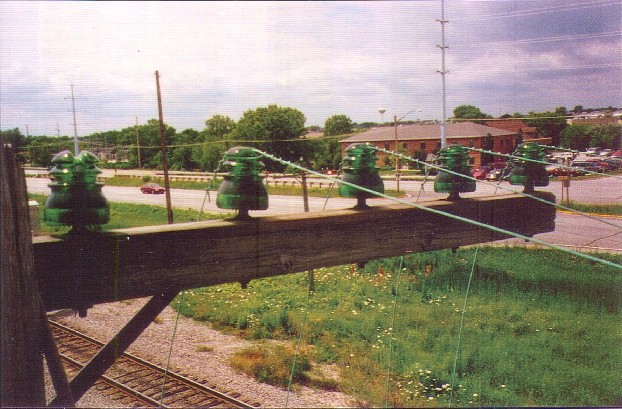
I came to find the first of several poles of these while working in
Ashwaubenon, WI, which is part of the greater Green Bay area and home to Lambeau
Field.
This line runs through a primarily industrial area, and after searching
the rest of the line, the total poles with 7-up CD 214 Hemingray-43s was five.
Each seems to have been a replacement pole at a crossing where the lines needed
to be raised for clearance over a road.
I called a signal maintainer I'm
acquainted with in Green Bay and asked if he would like these lines taken down.
He agreed, stating that he needed to get those removed over the crossings
anyway. Great! Off to get the bucket truck and do some wreck-out! I ended up
with approx. 60-70 of these after that trip (not all mint!).
A few weeks later I
found one more pole full of 7-up greens several miles south of town in a corn
field. I almost couldn't believe what I was seeing. . . three doubled-up
crossarms full of these beauties. That's 60 pieces!!! Problem --- the pole was
enormous (approximately 50'), and was completely rotted at the base. Climbing
was out of the question, so the only way to get my hands on these was to drop
the pole and hope the plowed field would soften the landing. So I climbed the
next pole and began cutting the lines. I returned to the "big one",
gave it a shove with one hand, and down she came. To my dismay I then found
myself front row center for a lovely show of airborne shards of green glass!
Unfortunately, about two-thirds were destroyed. Big Fun, nonetheless! --- Photo and story by John Scherzinger, Appleton, Wisconsin
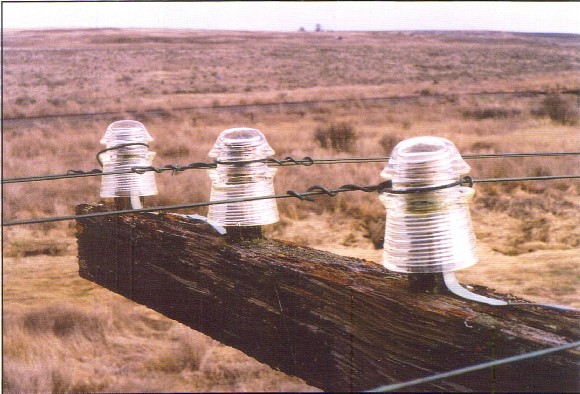
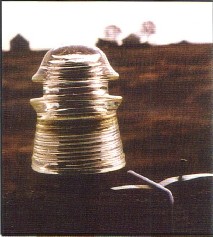
Bob and Betty Waring of Unity, Pennsylvania share
this installation photo of a CD 122.4 toll line somewhere in Montana.
CD 122.4s with copper liners and attached straps were tacked or secured to the top surface of the
crossarm. On a long distance carrier circuit open wire line, the amount of signal current leakage, especially in wet climates, was something to be reckoned with. Due to varied conditions, the amount of leakage between both wires of a carrier circuit pair will not be the same, causing an overall electrical imbalance of the individual carrier circuit. This imbalance had a detrimental effect on transmission of the carrier signal, especially at the higher frequencies. As I stated in my original post, the bonding was to balance, or equalize the loss between both wires of a carrier circuit pair. None of the bonding I found had connections to ground, or adjacent sets of pins. Doing so would cause interference with adjacent carrier circuits, or drain energy from the line to ground. The impedance balance and isolation of the single pair was the key, as I recall. Notice on later era toll lines the 8" spacing between circuit pairs, and the 10" to 12" spacing between the pairs themselves on the crossarm.
--- Bart Magoffin, Roseville Telephone Company, Roseville, California
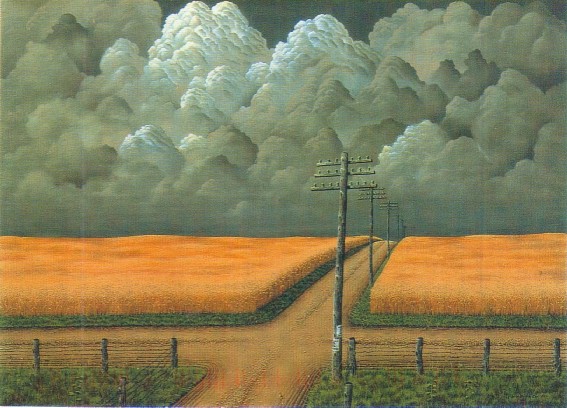
Grey and Gold, 1942 John Rogers, Cox, American, 1915-1990
This is my favorite painting of insulators in the air. I had a print for
which I built a frame nearly 25 years ago, and it has hung in each house we
have lived in since.
I could picture such a road in rural Kansas, with storm
clouds gathering. Several years ago, I tried to find out where I had gotten the
print and I kept thinking the painting was entitled "The Gathering
Storm." I used the internet to search multiple galleries, but to no avail.
Out of the blue, we received a postcard from our oldest son. He had been to the
Cleveland (Ohio) Museum of Art, recognized the original painting as the print we
had in our home when he was growing up. Mystery solved!
The postcard sent was
the print I had been trying to locate.
(John and Carol McDougald collection.)
CORNING'S COLORFUL CARNIVAL
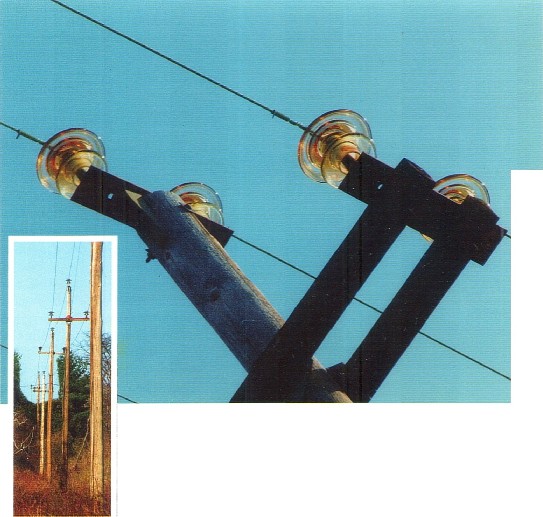
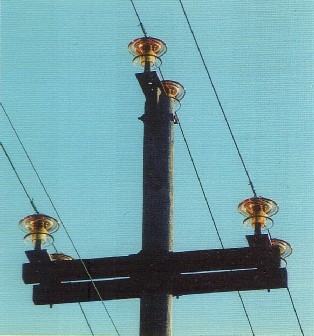
John and Andrea deSousa, East Granby, Connecticut, found this line of large
Pyrex carnival power pieces still in service in New England.
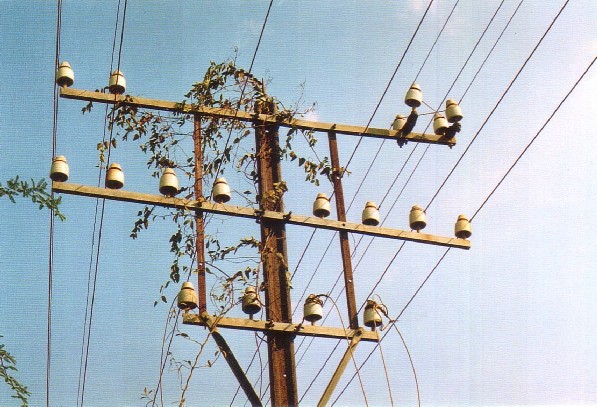
Thomas Iannelli, London, Ontario, is a mineral exploration geologist by trade
and has had the opportunity to travel to many exotic and unusual settings.
"Throughout the 2001 and 2002 'field seasons' I worked on a variety of
projects in northwestern and southeastern India. I traveled quite widely and had
a chance to work along several of the old railway lines. Of course, I had
visions of finding long abandoned ancient porcelain and glass insulators --
remnants of the original telegraph hardware from the reign of British
Raj. However, reality quickly settled in as I discovered that all of the
material currently up in the air and scattered around the pole sites was quite
new and of limited variety. One could store an entire Indian insulator collection
on one shelf! All of the material, that I encountered, was relatively new and
consisted of quite mundane white porcelain pieces such as those on this
telegraph pole situated along the South Central Railway about 8 km
south-southeast of Kodur, southeast Andhra Pradesh State, India.
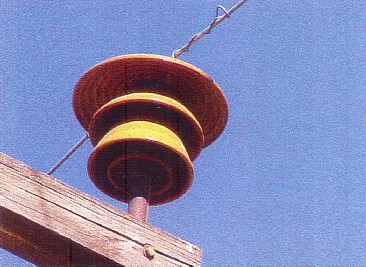
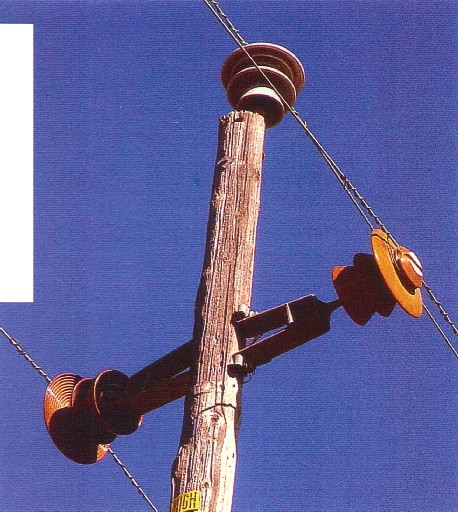
A "screaming yellow" M-4415 six-ring Thomas is pictured above.
At
the right, a rare M-4382 ten-ring Thomas, probably a common Ohio Brass, and a
nice Thomas M-4415 ten-ring power piece.
"Somewhere" in northern California, there are awesome insulators
still in service. Bill Rohde, Williams, California captured these pictures in August 200l.
SUNRISE
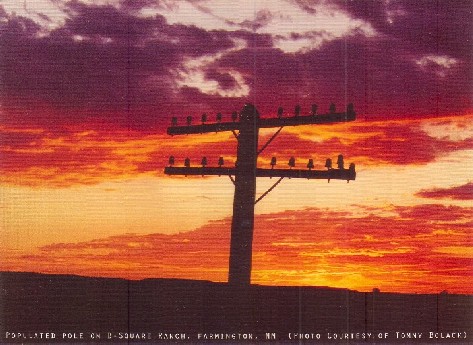
SUNSET
| 